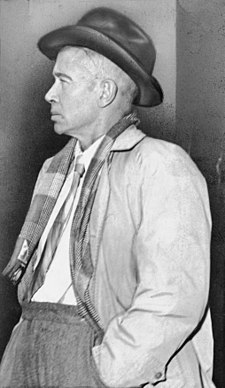From Wikipedia, the free encyclopedia
|
E. E. Cummings |

E.E. Cummings in 1953 |
| Born |
Edward Estlin Cummings
October 14, 1894
Cambridge, Massachusetts |
| Died |
September 3, 1962 (aged 67)
North Conway, New Hampshire |
| Cause of death |
Stroke |
| Resting place |
Forest Hills Cemetery |
| Known for |
poems and other works of art |
| Religion |
Unitarian |
|
Spouse(s) |
Elaine Orr
Anne Minnerly Barton
Marion Morehouse |
| Children |
Nancy, daughter with Elaine Orr |
| Parents |
Edward Cummings
Rebecca Haswell Clarke |
| Relatives |
Elizabeth Cummings, sister |
Edward Estlin Cummings (October
14, 1894 – September 3, 1962), popularly known as E. E. Cummings,
with the abbreviated form of his name often written by others in lowercase
letters as e. e. cummings (in
the style of some of his poems), was an
American poet, painter, essayist, author, and playwright. His body of work
encompasses approximately 2,900 poems, two autobiographical novels, four plays
and several essays, as well as numerous drawings and paintings. He is
remembered as a preeminent voice of 20th
century poetry, as well as one of the most popular.
Early
years
Cummings was born in Cambridge,
Massachusetts, on October 14, 1894, elder of two children to Edward
Cummings and Rebecca Haswell Clarke.[1] His
younger sister, Elizabeth, was born in 1901.
He was named after his father but his family called him by his middle name,
Estlin.[2] His
father was a professor of sociology and
political science at Harvard
University and later a Unitarian minister.[3] Cummings
described his father as a person who could accomplish anything that he wanted
to. Edward was well skilled and was always working or repairing things. He and
his son were close, and Edward was one of Estlin's most ardent supporters.
His mother never partook in stereotypically "feminine" things, and enjoyed
reading poetry to her children. Raised in a well-educated family, Cummings was
a precocious boy and his mother encouraged Estlin to write poetry every day.
He wrote his first poem when he was only three: "Oh,the pretty birdie,O;/with
his little toe,toe,toe!"[4]
His boyhood home, the E.E.
Cummings House, is located in Cambridge, Massachusetts, and is listed on
the National
Register of Historic Places.[5]
Education
In his youth, Estlin Cummings attended Cambridge
Latin High School in Cambridge,
Massachusetts. Early stories and poems were published in the school newspaper,
Cambridge Review.
Cummings enrolled at Harvard
University in September 1911,
from which he received a
Bachelor of Arts degree in 1917
and a Master's
degree for English and
Classical Studies in 1916. While at Harvard, he befriended John
Dos Passos, at one time rooming in Thayer Hall, named after the family of
one of his Harvard acquaintances, Scofield
Thayer, and not yet a freshman-only dormitory.[6] Several
of Cummings' poems were published in the Harvard Monthly as
early as his sophomore year. Cummings himself labored on the school newspaper
alongside fellow Harvard
Aesthetes Dos Passos and S.
Foster Damon. In 1915, his poems were published in the Harvard
Advocate.
In his final year at Harvard, Cummings was influenced by writers such as Gertrude
Stein and Ezra
Pound. He graduated magna
cum laude in 1916,
delivering a controversial commencement address entitled "The New Art". This
speech gave him his first taste of notoriety, as he managed to give the false
impression that the well-liked imagist poet,
Amy Lowell, whom he himself admired, was "abnormal". For this, Cummings
was chastised in the newspapers. In 1917, Cummings' first published poems
appeared in a collection of poetry entitled Eight
Harvard Poets.
Career
In 1917 Cummings enlisted in the Norton-Harjes Ambulance Corps, along with his
college friend John
Dos Passos. Due to an administrative mix-up, Cummings was not assigned to
an ambulance unit for five weeks, during which time he stayed in Paris.
He fell in love with the city, to which he would return throughout his life.
On September 21, 1917, just five months after his belated assignment, he and a
friend,
William Slater Brown, were arrested on suspicion of espionage.
The two openly expressed
anti-war views; Cummings spoke
of his lack of hatred for the Germans.[7] They
were sent to a military detention camp, the Dépôt
de Triage, in La Ferté-Macé, Orne, Normandy,
where they languished for 3½ months. Cummings' experiences in the camp were
later related in his novel, The
Enormous Room about which F.
Scott Fitzgerald opined, "Of
all the work by young men who have sprung up since 1920 one book survives- The
Enormous Room by e e cummings....Those
few who cause books to live have not been able to endure the thought of its
mortality."[8]
He was released from the detention camp on December 19, 1917, after much
intervention from his politically connected father. Cummings returned to the
United States on New Year's Day 1918. Later in 1918 he was drafted into the army.
He served in the 12th
Division at Camp
Devens, Massachusetts, until November 1918.[9][10]
Cummings returned to Paris in 1921 and remained there for two years before
returning to
New York. During the rest of the 1920s and 1930s he returned to Paris a
number of times, and traveled throughout Europe,
meeting, among others, Pablo
Picasso. In 1931 Cummings traveled to the Soviet
Union and recounted his
experiences in Eimi,
published two years later. During these years Cummings also traveled to Northern
Africa and Mexico
and worked as an essayist and portrait artist for Vanity
Fair magazine (1924 to
1927).
Cummings' papers are held at the Harry
Ransom Center at the University
of Texas at Austin.



























































